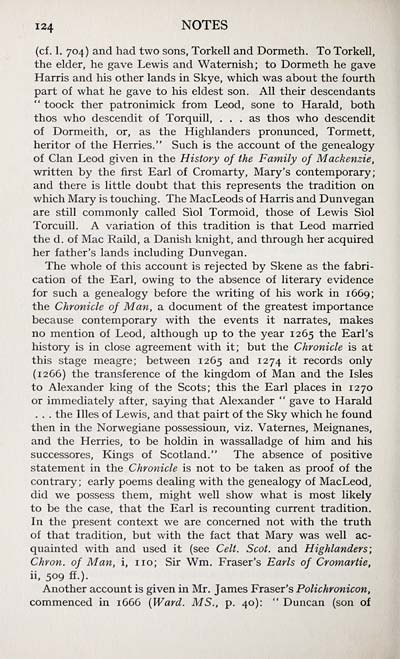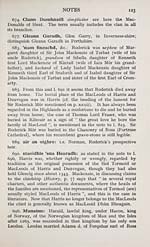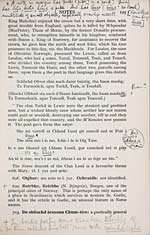Download files
Complete book:
Individual page:
Thumbnail gallery: Grid view | List view

124 NOTES
(cf. 1. 704) and had two sons, Torkell and Dormeth. To Torkell,
the elder, he gave Lewis and Waternish; to Dormeth he gave
Harris and his other lands in Skye, which was about the fourth
part of what he gave to his eldest son. All their descendants
" toock ther patronimick from Leod, sone to Harald, both
thos who descendit of Torquill, ... as thos who descendit
of Dormeith, or, as the Highlanders pronunced, Tormett,
heritor of the Herries." Such is the account of the genealogy
of Clan Leod given in the History of the Family of Mackenzie,
written by the first Earl of Cromarty, Mary's contemporary;
and there is little doubt that this represents the tradition on
which Mary is touching. The MacLeods of Harris and Dunvegan
are still commonly called Siol Tormoid, those of Lewis Siol
Torcuill. A variation of this tradition is that Leod married
the d. of Mac Raild, a Danish knight, and through her acquired
her father's lands including Dunvegan.
The whole of this account is rejected by Skene as the fabri-
cation of the Earl, owing to the absence of literary evidence
for such a genealogy before the writing of his work in 1669;
the Chronicle of Man, a document of the greatest importance
because contemporary with the events it narrates, makes
no mention of Leod, although up to the year 1265 the Earl's
history is in close agreement with it; but the Chronicle is at
this stage meagre; between 1265 and 1274 it records only
(1266) the transference of the kingdom of Man and the Isles
to Alexander king of the Scots; this the Earl places in 1270
or immediately after, saying that Alexander " gave to Harald
. . . the Illes of Lewis, and that pairt of the Sky which he found
then in the Norwegiane possessioun, viz. Vaternes, Meignanes,
and the Herries, to be holdin in wassalladge of him and his
successores. Kings of Scotland." The absence of positive
statement in the Chronicle is not to be taken as proof of the
contrary; early poems dealing with the genealogy of MacLeod,
did we possess them, might well show what is most likely
to be the case, that the Earl is recounting current tradition.
In the present context we are concerned not with the truth
of that tradition, but with the fact that Mary was well ac-
quainted with and used it (see Celt. Scot, and Highlanders;
Chron. of Man, i, no; Sir Wm. Eraser's Earls of Cromartie,
ii, 509 fE.).
Another account is given in Mr. James Eraser's Polichronicon,
commenced in 1666 {Ward. MS., p. 40): " Duncan (son of
(cf. 1. 704) and had two sons, Torkell and Dormeth. To Torkell,
the elder, he gave Lewis and Waternish; to Dormeth he gave
Harris and his other lands in Skye, which was about the fourth
part of what he gave to his eldest son. All their descendants
" toock ther patronimick from Leod, sone to Harald, both
thos who descendit of Torquill, ... as thos who descendit
of Dormeith, or, as the Highlanders pronunced, Tormett,
heritor of the Herries." Such is the account of the genealogy
of Clan Leod given in the History of the Family of Mackenzie,
written by the first Earl of Cromarty, Mary's contemporary;
and there is little doubt that this represents the tradition on
which Mary is touching. The MacLeods of Harris and Dunvegan
are still commonly called Siol Tormoid, those of Lewis Siol
Torcuill. A variation of this tradition is that Leod married
the d. of Mac Raild, a Danish knight, and through her acquired
her father's lands including Dunvegan.
The whole of this account is rejected by Skene as the fabri-
cation of the Earl, owing to the absence of literary evidence
for such a genealogy before the writing of his work in 1669;
the Chronicle of Man, a document of the greatest importance
because contemporary with the events it narrates, makes
no mention of Leod, although up to the year 1265 the Earl's
history is in close agreement with it; but the Chronicle is at
this stage meagre; between 1265 and 1274 it records only
(1266) the transference of the kingdom of Man and the Isles
to Alexander king of the Scots; this the Earl places in 1270
or immediately after, saying that Alexander " gave to Harald
. . . the Illes of Lewis, and that pairt of the Sky which he found
then in the Norwegiane possessioun, viz. Vaternes, Meignanes,
and the Herries, to be holdin in wassalladge of him and his
successores. Kings of Scotland." The absence of positive
statement in the Chronicle is not to be taken as proof of the
contrary; early poems dealing with the genealogy of MacLeod,
did we possess them, might well show what is most likely
to be the case, that the Earl is recounting current tradition.
In the present context we are concerned not with the truth
of that tradition, but with the fact that Mary was well ac-
quainted with and used it (see Celt. Scot, and Highlanders;
Chron. of Man, i, no; Sir Wm. Eraser's Earls of Cromartie,
ii, 509 fE.).
Another account is given in Mr. James Eraser's Polichronicon,
commenced in 1666 {Ward. MS., p. 40): " Duncan (son of
Set display mode to: Large image | Transcription
Images and transcriptions on this page, including medium image downloads, may be used under the Creative Commons Attribution 4.0 International Licence unless otherwise stated. ![]()
| Early Gaelic Book Collections > Matheson Collection > Gaelic songs of Mary MacLeod > (164) |
|---|
| Permanent URL | https://digital.nls.uk/76611570 |
|---|
| Description | Items from a collection of 170 volumes relating to Gaelic matters. Mainly philological works in the Celtic and some non-Celtic languages. Some books extensively annotated by Angus Matheson, the first Professor of Celtic at Glasgow University. |
|---|
| Description | Selected items from five 'Special and Named Printed Collections'. Includes books in Gaelic and other Celtic languages, works about the Gaels, their languages, literature, culture and history. |
|---|

